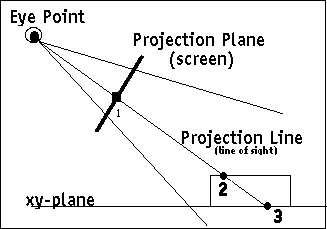TAPESTRY: The Art of Representation and Abstraction
Modeling
The Ambiguity of Viewing
The figure at right shows a Wireframe view of a simple box. Notice the dot? That single 2D image location could represent a point on the top-front edge of the box, or it could represent a point on the back-bottom edge of the box. The picture is ambiguous. This is partly due to the fact that the wireframe view itself is ambiguous as to whether we're looking at a solid "block" or an open-topped "box". If we can only see some surfaces or edges of the geometry, we assume they are the ones we want to talk about. In fact, we're not sure if we're looking down on the shape from above, or up from below. Either way it makes sense.
shows a Wireframe view of a simple box. Notice the dot? That single 2D image location could represent a point on the top-front edge of the box, or it could represent a point on the back-bottom edge of the box. The picture is ambiguous. This is partly due to the fact that the wireframe view itself is ambiguous as to whether we're looking at a solid "block" or an open-topped "box". If we can only see some surfaces or edges of the geometry, we assume they are the ones we want to talk about. In fact, we're not sure if we're looking down on the shape from above, or up from below. Either way it makes sense.
The Ambiguity of Pointing
 Now, consider the problem of indicating positions in 3D space using a 2D input device such as a mouse. The diagram at right may help. This drawing shows a section cut vertically along the viewer's line of sight. Perpendicular to the line of site is the projection plane, which we can also think of as the monitor screen. The mouse is restricted to identifying points on the screen, but the program must identify points in space if we are to build a 3D model. The problem is that if we click at screen location #1 in the figure, there is ambiguity as to where we are pointing in 3D. We could be pointing at point #2, or point #3. In fact, we could be pointing anywhere along the projection line.
Now, consider the problem of indicating positions in 3D space using a 2D input device such as a mouse. The diagram at right may help. This drawing shows a section cut vertically along the viewer's line of sight. Perpendicular to the line of site is the projection plane, which we can also think of as the monitor screen. The mouse is restricted to identifying points on the screen, but the program must identify points in space if we are to build a 3D model. The problem is that if we click at screen location #1 in the figure, there is ambiguity as to where we are pointing in 3D. We could be pointing at point #2, or point #3. In fact, we could be pointing anywhere along the projection line.
Last updated: April, 2014
